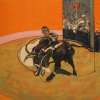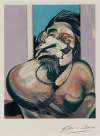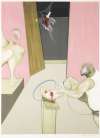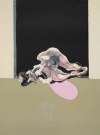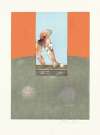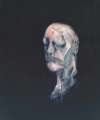Three
Studies Of The Male Back
After his Three Studies Of The Male Back, this collection of Francis Bacon prints contains nude portraits of Bacon’s muse, George Dyer. He depicts a contorted figure in a cage-like construction, facing away from the viewer and staring into a mirror; a voyeuristic portrayal of the lover as a painfully self-possessed entity.
Francis Bacon Three Studies Of The Male Back For sale
Three Studies Of The Male Back Value (5 Years)
With £33738 in the past 12 months, Francis Bacon's Three Studies Of A Male Back series is one of the most actively traded in the market. Prices have varied significantly – from £3660 to £38000 – driven by fluctuations in factors like condition, provenance, and market timing. Over the past 12 months, the average selling price was £16869, with an average annual growth rate of 4.38% across the series.
Three Studies Of The Male Back Market value
Auction Results
| Artwork | Auction Date | Auction House | Return to Seller | Hammer Price | Buyer Paid |
|---|---|---|---|---|---|
Three Studies Of The Male Back Francis Bacon Signed Print | 31 May 2024 | Sotheby's Edinburgh | £16,150 | £19,000 | £19,000 |
 Three Studies Of The Male Back (centre panel) Francis Bacon Signed Print | 3 May 2023 | Osenat, Fontainebleau | £5,100 | £6,000 | £7,500 |
 Three Studies Of The Male Back (left panel) Francis Bacon Signed Print | 14 Sept 2022 | Sotheby's Online | £5,950 | £7,000 | £9,500 |
 Three Studies Of The Male Back (right panel) Francis Bacon Signed Print | 14 Jun 2022 | Phillips London | £6,800 | £8,000 | £10,500 |
Sell Your Art
with Us
with Us
Join Our Network of Collectors. Buy, Sell and Track Demand
Meaning & Analysis
Entitled Three Studies Of The Male Back, this collection of prints from Irish-born British painter Francis Bacon affords an in-depth view of a 1970 oil-on-canvas triptych of the same name. Each print constitutes a lithograph copy of a single panel from this tri-partite painting, which portrays the body of Bacon’s onetime lover and muse, George Dyer. Every panel – and print – places the male form at its centre. Housed within a cage-like construction (a framing device typical of many Bacon triptychs) and facing away from the viewer, the paintings show a contorted, humanoid figure, seated on a swivel stool and staring into a mirror. Much like the artist’s Bull Fight collection, which features prints including Study For Bullfight (right panel) (1980) and Study For Bullfight (centre panel) (1990), this collection stands at the intersection of the human and the animal.
In both Three Studies Of A Male Back (left panel) (1987) and Three Studies Of The Male Back (right panel) (1987), the mirror beams a distorted snapshot of the figure’s head back towards the viewer. An echo of the deconstructive approach of Bacon’s Portraits collection, a particularly visceral human head is gesturally depicted with broad strokes of thickly applied red, white, and black hues. In Three Studies Of The Male Back (centre panel) (1987), the human body re-appears in an almost non-human manifestation; melting away into a fluid-like assemblage of curved lines and ellipses, Dyer’s spine appears to fuse with geometric lines that stand proudly above a hard-edged blue horizon.
This collection showcases George Dyer – a career criminal from London’s East End and Bacon’s muse – and outlines his importance to the artist’s wider œuvre. The pair first met in 1963, but as a much-mythologised story dictates, it is unknown where this meeting took place. Some say the duo first crossed paths in a Soho drinking hole, the kind Bacon often frequented, whilst others say they first met eyes in Bacon’s flat when Dyer decided to burgle it. The latter episode, immortalised by the 1998 film, Love Is The Devil: Study for a Portrait of Francis Bacon, is now widely denounced as false. Yet this does little to undermine the significance of the pair’s relationship – and interdependence – nor the string of paintings it produced. Whether Dean Street’s Colony Room Club (a haunt of YBAs Tracey Emin and Damien Hirst, amongst many others), the Coach and Horses on Greek Street, or the landing of Bacon’s house, the pair’s first meeting place is irrelevant. What is sure – and as this painting highlights – is that their personal and romantic relationship went on to become a defining feature of Bacon’s life and work.




